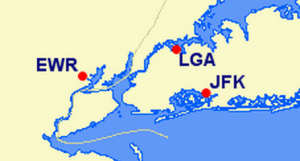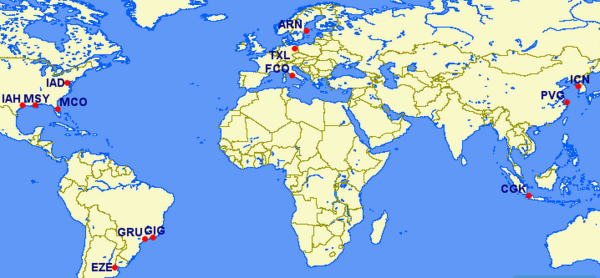Winning the Hearts and Minds of Airline Phone Agents: When Things Go Wrong
On Wednesday, we looked at how to talk with agents for complicated award bookings, with a focus on making the conversation as quick and painless as possible.
Today, we’ll look at (as many reasons I could think of) what to do when the agent hits a snag or can’t book an award ticket. Sometimes it’s a matter of training on their end, other times you may need to study the rules a bit more.
Above All, Approach Snags with a Collaborative, Inquisitive, and Perhaps Slightly Naive Attitude
If the agent comes back saying there’s a problem, you have a few options.
- Hang Up call Again (particularly if the agent has shown any kind of resistance, attitude, or has been particularly misinformed/undertrained - not knowing partners or airport codes is usually a HUCA situation). Anecdotally, this happens to me about 1 in 3 times.
- Diagnose the problem (if you think it’s a minor snag). You have to make the judgment call that the agent is trying to help you and wants to book the seat for you. If you get any hint that they are annoyed (maybe they were about to go on break when you dropped a monster booking on them), or think you have too many segments, you’re better off trying again. Similarly, if “the computer isn’t working” or the agent seems to take an inordinate amount of time to take and enter each segment, you may be better off starting over.
Hang Up. Call Again
Remember that your sunk time should never factor into whether you should hang up. Gary at View from the Wing has a pretty good play by play of a classic HUCA situation, that even when you’re “close” adding all the segments in, you may still need to start from scratch. My breaking point is if an agent quotes a rule I know is wrong (unless it’s in my favor).
If you find yourself needing to get out of the conversation, I usually say something to the effect “Oh my goodness, I’m late for a meeting! I will call back later to book this ticket. Thank you for your time!” It’s polite, creates urgency and ends the call swiftly. Gary also has some good advice on this - especially to avoid notes in your record. “I’ve got a call on the other line. Got to Go!” Works too. (HT Ben)
But sometimes you’ll have an agent that’s perfectly happy to help, but you hit a snag. Here’s a list of them below and how to handle them. Add more in the comments and I’ll update the post.
The Most Common Problems
Hold times are longer than the last Ice Age and you want to catch a flight in the next hour
International call center numbers are clutch in these situations. Massive storms hit the East Coast? Call sunny Australia or Singapore. With the advent of Voice Over Internet Protocol (VOIP) calling, using Skype or Google Voice will cost you practically nothing and the agents in countries without a backlog have the same access to the same seats that the US agents have.
Everything pricing at highest cabin
If you’re pricing an international itinerary in economy and one segment (even domestically) is in First, then the whole itinerary will price at the higher cabin cost. Some airlines like Delta and United will allow you to book the outbound and return in different classes and split the difference between the two (if you want to sleep on the way to Europe, but don’t care on the way back). Make sure they aren’t applying business class pricing to the whole itinerary and be very careful of “mixed cabin awards” since you could be going over the ocean in coach and connect to a 45 minute intra-Europe business class flight and be charged the full transoceanic price. The carriers are getting better at not presenting these options, but they are still out there.
Everything pricing at Standard or High Level instead of Saver or Low Level Prices

It’s not intuitive, but the itinerary below is pricing at the standard award level on the outbound, bumping the price from 62,500 miles to 100,000 miles. The return is the same at 62,500 miles.
Similar to the cabin issue (and harder to diagnose). When you have segments with the carrier that you’re redeeming miles with, it’s very easy to mistakenly see that segment using Standard availability (UA) or Peak (DL) or AAnytime Level inventory (AA) and think it’s Saver or Low. Honest mistake, keep searching.
Award prices as a roundtrip even though it’s a one way

Delta is finally introducing one way pricing!
Delta and US Airways (and some international carriers) charge roundtrip prices for one way awards. This will be going away in the US with the US/AA merger and new 2015 Skymiles changes, but may still be an issue on a carrier like ANA
Regional superiority / Routing Rules

Drew has probably the best understanding of United routing rules - see his posts at travelisfree.com
In a few cases, make sure you really understand the routing rules of a carrier. AA requires a fare to be published/marketed between two city pairs and does not allow transiting a third region in many case (No Asia via Europe). UA has a murkier set of rules that assign certain regions higher weight in calculating award prices (which they are apparently changing soon HT: Drew at TravelIsFree. From experience, if you try to fly Barcelona to Bangkok via Tokyo using UA miles, it will price as Europe-Japan, not Europe-Southeast Asia.
Itinerary Breaks into Two Tickets
Sometimes an itinerary will break into two awards based on how it was inputed. For region-based award charts, it can help to ask “This is a roundtrip between North America and Southeast Asia with one open jaw and a stopover right? According to your award chart it looks like it should be ____ miles.” Similarly, overnight connections/crossing the dateline can cause some snags in pricing, but simply highlighting the structure of the overall ticket can resolve the issue. Make sure you don’t have more than the maximum number of stopovers or segments (varies by carrier), a ground segment or open-jaw that isn’t at an origin or destination. For example, SFO-FRA, LHR-AMS, AMS-ORD-SFO (open jaw at LHR-FRA) generally is not allowed. Some carriers (SQ) also prevent backtracking, though this is nebulous at times.
Once in a while, a coterminal change may be counted as a ground segment (NYC, TYO, LON vs. JFK, NRT, LHR) so make sure the agent is using the city code (LON) in the computer instead of the airport code (LHR).

Searching NYC will search flights to all three airports. They are coterminals and an agent may book something impossible like getting from JFK to EWR in an hour (overnight is generally fine). If inputted as separate airports instead of a city code, the computer may think there’s a ground segment.
It’s better to do this after listing out the segments (and only if it prices incorrectly) so the agent doesn’t get an initial idea of what it should cost (or worse, that they conclude from the outset that it should cost more)
No Space Available
Wrong Carrier
“Are we sure that we’re searching CA for Air China and not AC? That’s Air Canada” - Some carriers have non-intuitive call signs, so an agent may not know EVA is BR or Etihad is EY and not ET (Ethiopian). You tell me if you know China Eastern or Southern off the top of your head 
Wrong Airport, Particularly Those That Don’t Match the City’s Name

Non-intuitive airport codes - Agents that don’t book a lot of international travel may get tripped up by these. EZE is in Europe right?
Sao Paulo (GRU), Rio De Janeiro (GIG), Rome (FCO), Stockholm (ARN) Berlin (TXL), Seoul (ICN), Buenos Aires (EZE), Shanghai (PVG) and Jakarta (CGK) can often trip up agents, particularly if they aren’t used to international itineraries. You may be looking for space to San Pablo, Spain or Marquette, MI.
Similarly, a coterminal change might cause problems because the agent isn’t including secondary airports in their searches. You might be flying into Heathrow and out of Gatwick the next day to IST, but the agent is only searching LHR-IST and saying nothing is available.
Dallas and Dulles sound pretty similar, no? What about San Jose, CA, San Jose del Cabo, Mexico and San Jose, Costa Rica? Granada, Spain and Grenada?
Wrong Dates
I plan on overnighting in Frankfurt and taking the next segment to Bangkok the following morning. Are we searching the FRA-BKK segment on the 10th or the 11th? Because of the way US Airways stores its flights, some segments departing just after midnight might only be visible if the agent searches the previous day.
Wrong Fare Class
“Just to confirm, we’re searching (I) fare class availability right?”
Not Enough Award Seats for Your Party
Be certain in your searches that you are finding availability for the right number of passengers. Many sites default to searching for one seat if you start over.
Pulling Your Own Inventory
One time while booking a Korean segment with Delta, I kept seeing the seat on the website and would call in, but while talking with the agent, the seat would disappear. Given that I was booking at 2am PST, I realized that I wasn’t competing with other passengers for that award seat, but every time the agent pulled the seat to assemble the itinerary, it would be taken out of inventory. If I called back to restart building the itinerary too soon, it would be gone and would take 10-15 minutes to show up again.
Partner Space vs. Carrier’s Own Space

Remember, partner awards are only available at the saver level (on nearly all carriers/alliances) AAnytime Awards are only available when using AA miles, not Avios.
Double check that you are looking at space made available to partners and not the carrier’s own members. This can happen when searching for availability on Alaska’s site, and then calling BA to use Avios to book. Carriers usually make more seats available on their metal available to their own members than for people using partner miles.
Non-alliance Combinations
Double check that you can include alliance and non-alliance partners on the same itinerary. Some programs like Alaska will only let you combine their own flights with one partner, so a Emirates/Cathay Pacific round the world ticket isn’t possible unless you break it up into two awards. Similarly, US airways has some partners remaining from Star Alliance, but they cannot be combined with new OneWorld partners. Delta and United tend to have fewer issues combining non-alliance and alliance partners in the same award, though watch that the fare classes correspond to the correct cabin class. T and G on Virgin Atlantic sound the same over the phone, but they are a world apart on the plane.
Violates Routing Rules / Not a Valid Routing
No published route, maximum permitted mileage and backtracking
American requires that the carrier operating the longhaul segment publish a fare between the two cities. (Use Google or ITA to verify that there is a price from point A to point B). Moreover, many carriers have a maximum permitted mileage (MPM) allowed between two city pairs, so booking a flight to Europe that zigzags from JFK-LAX-IST-LHR is probably not going to fly. You can find most MPMs on Expertflyer.
No reason given or “the seat must have just been booked by another passenger”

- Sometimes you just get an uncooperative agent.
Computer Says No!
This one is much harder to resolve, because it implies that the agent isn’t on your side or that you’ve made a mistake. It’s statistically VERY unlikely that someone is booking the same seat you are unless availability on that route is intensely scarce (LAX-SYD on Qantas). I’ve had very simple itineraries scuttled because an agent got it in their head that I was breaking the rules. In one instance, I had booked BCN-FRA-NRT-BKK. I wanted to change the BCN-FRA segment to the night before (making it a 16 hour layover instead of 6 hours) and was told I cannot make changes even as a 1K. Easy enough to cancel and rebuild, but annoying since it is definitely allowed under the published rules.
There are plenty of instances where you will be in the wrong, for some obscure rule you didn’t see. That’s the beauty of the game and why award booking is an art as much as it’s a science. Flyertalk and Milepoint are great for diagnosing why something worked or didn’t, but you must approach these forums with a tone of wanting to learn, not a place to complain. You will be schooled if you come off as whiny. You have been warned.
Agents also have a lot of power and can annotate a record. If you are rude or dismissive to an agent, they can easily add restrictions to existing itineraries and make it much more difficult to make changes in the future. There is no benefit to acting entitled, lecturing or arguing about a policy if it’s quoted incorrectly. You aren’t there to train them.
Understand What Actions and Changes can Trigger Fees
You’ve pieced together the itinerary and the agent found space on all the segments and you’re in the home stretch. Then the agent comes back and says, “Ok it will be 140k miles and $2,743.87 in taxes” WHAAA?
Airport Taxes and airline fees are often calculated incorrectly/arbitrarily
I’ve certainly paid my share of change fees and it’s important to understand what changes will trigger a fee. UA unofficially allows date changes if the flight you’re changing to is more than 21 days out, though it’s very common for the taxes and fees to change even when moving one segment by one day (which leads me to believe that they are arbitrarily defined and collected incorrectly - I doubt Germany just changed their airport taxes overnight).
While not completely accurate, this resource might be helpful in knowing whether you are connecting through a low tax country (Netherlands) or a high tax country (Australia). Flights departing London, or with connections greater than 24 hours there will be levied an onerous UK departure tax. France is similarly expensive, but if you start your return itinerary from Madrid or Amsterdam you could save a few hundred bucks.
AA similarly has some generous options if you know how fees are triggered. Delta doesn’t allow changes within 72 hours of the first departure (though generally you can modify segments more than 72 hours out). US allows no changes once travel has commenced unless there’s irregular operations. Highlighting that you’re changing your itinerary due to an airline misconnect can net you some dollars in saved fees.
Fuel Surcharges
One tradeoff with using international carrier miles (BA, SQ) is that even though the fuel charges can be high, the change fees are comparatively lower than US carriers. If you are booking a trip that you have a feeling may change, or you want the flexibility, it may make sense to pay the YQ for $30 changes later. Typically BA, LH, AF, QF, VS flights will tack on huge surcharges, while LO, IB, AB, LX and almost all carriers in the western hemisphere, will be (comparatively) less painful.
If you want to avoid surcharges entirely, but still fly some great (nearly unattainable products), booking a ticket departing from Brazil will kill almost all fuel-related fees, but only if the ticket starts there. SQ, KE, QR, TK, EK, EY, LH and LX all fly there and have great F/J products, so why not book an inter-region open jaw on Delta NA-SA, Europe-NA and add in a SQ F flight for $35?
Phone Booking and Award Processing Fees
For the phone booking fee, status and being polite can really help. I often reference that I couldn’t have booked online and ask whether they can waive the fee because I had no other options (sometime they do!)
If I have status with an airline, it can be really helpful to listen for “Thank you for being a platinum member” or to double check your account number (“My number is 3R5G67G - I think that’s platinum right?”) so that you aren’t inadvertently charged fees that aren’t supposed to be assessed.
You may be able to justify some of these costs by consuming the equivalent value (or more) in champagne like this guy.
Waitlisting
For some airlines, it is still possible to book an award with some segments in a lower cabin and “waitlist” for an upgrade when/if seats open up (These may be highlighted as “mixed cabin”). If this is ok with you, do it, but be aware that the airline may try to charge a fee for the privilege of doing so. I generally take the attitude of “booked seat or nothing” and that it’s generally better to find an entire itinerary on the carriers and cabins you want, but I’m also the type that’s really flexible with travel dates and comfortable with waiting close to departure when space is considerably more abundant.
Use Sources that Sound More Credible
While it’s tempting to quote a rule from the bowels of flyertalk, you’ll just come off as those over-entitled customers UA likes to hate on. It’s much better to say things like:
- “The last agent I talked to said that _______”
- “It looks like the website is pricing the outbound at _____, is that what you’re seeing?”
- “I was advised by the airport staff to call in to make this change” - particularly useful if the agent tells you that “ticketing changes have to be made at the airport”. But this might be an agent that’s not going to be that helpful in the first place if they are giving you the runaround.
Trust but Verify
Even when you hang up, you aren’t done. Wait until the ticket is issued and in your inbox (make sure you actually see a ticket number). Then look at the itinerary and validate all of the fields on your piece of paper. I’ve caught on several instances inaccuracies to the passenger’s name, date of travel and cabin. These are much easier to resolve if the ticket was just issued (falls within 24 hour rule required by most regulatory authorities) than if you wait and try to resolve later.
I’ll often call the carrier back to get the record locators for each airline on the itinerary. Login to each carrier’s site to see if you can see the itinerary, assign a seat and book catering (if possible). If the partner carrier can’t see your record locator, you had better resolve it now than when travel is closer. United has had issues with this in the past with partners.
Conclusion
In conclusion, don’t approach the booking process with dread. You can often learn a lot about the airline and if you develop rapport, you will get better at doing it. Hopefully some of the tips above will make your next call go smoothly. Airline phone agents have a tough job. This is a pretty good read to understand what they go through.

When you learn to speak the magic language, things like this will happen!
Computer Says Yes!
Eventually, you’ll be able to do this is in real life.

No comments yet.